Best Campgrounds & Hiking Trails in Florida

As one of America’s most bio-diverse states, Florida boasts picturesque prairies, murky mangroves, teeming wetlands, and marine life-rich reefs. And let’s not forget its turquoise-tinged beaches—all 663 of them—which span a staggering 1300 miles of pristine coastline.
Couple this immense natural splendor with a warm year-round climate, and it’s little wonder the Sunshine State has become a mecca for nomadic outdoorsy types.
We’re covering its best hiking trails and campsites to help you make the most of this spectacular state. From the Panhandle down to the Key West, these are the most stunning spots to savor the great outdoors in Florida.
North Florida Campgrounds and Trails
With more live oak forests than palm-fringed beaches, North Florida challenges the perception of a steamy, subtropical state. Temperate nature reserves and warm Southern hospitality await.
Anastasia State Park Campsite
Tucked between towering white-quartz dunes, this 1600-acre peninsula showcases Florida’s diverse avifauna. Come sundown, a kaleidoscope of colorful species soar through the sky, from the majestic osprey to the vibrant roseate spoonbill. Meanwhile, sea turtles trudge through the weeds, and dolphins frolic offshore—the park is a highlight of the Great Florida Birding and Wildlife Trail.
A broad range of activities can bring you face-to-face with native animals, from cycling to hiking and kayaking. Don’t miss Coquina Quarry, a centuries-old rock mine that laid the foundations for the 17th-century town of St. Augustine. You’ll find 139 scenic campsites scattered around the park, most with the essential RV hook-ups and amenities.
La Chua Trail
Located in the Paynes Prairie Preserve State Park near Gainesville, this easy-going 3.1-mile hike is ideal for alligator spotting. The best place to glimpse these prehistoric reptiles is at the boardwalk near the start of the trail, where they gather to laze about in the murky marsh.
Here, you’ll also find the Alachua Sink, a natural sinkhole that drains water from the marsh. When it clogs up, the swamp floods, and rangers have to close the trail—don’t worry, it’s not a common occurrence. Head to the southern end of the state park if you want to meet its other famous residents: wild bison.
Blackwater River State Park Campsite
The mighty Blackwater River cuts through this majestic state park, which straddles the Alabama border in far north Florida. Kayakers, canoers, and tubers take to its pristine waterways each day, stopping to spot wildlife at golden sandbars en route. For the walkers, a string of pretty hiking trails (including leisurely boardwalk strolls) winds through thick forests of wiregrass and longleaf pines.
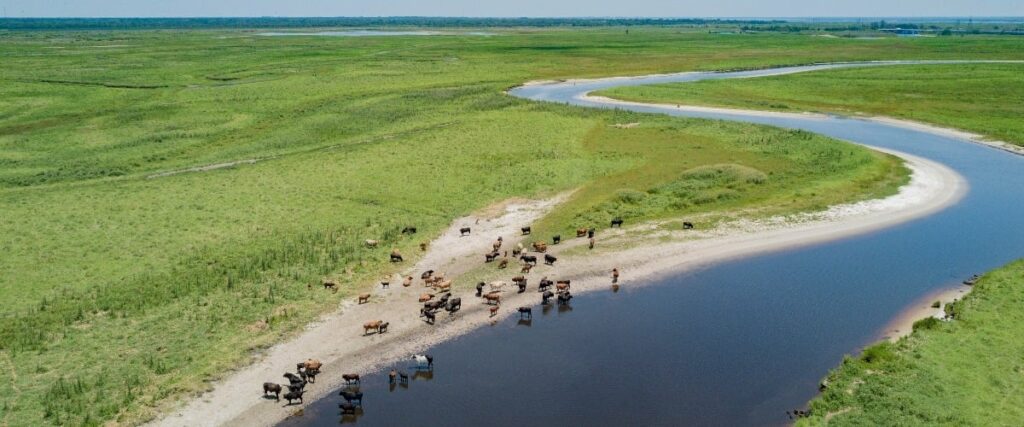
The park has just 30 campsites, so book early in peak season to snag a spot. Options range from secluded primitive camping to RV-friendly sites with all the trimmings. Road trippers passing through the seldom-visited Panhandle region will find Blackwater is well worth a night or two.
The Dune Ridge Loop
North of Jacksonville, this scenic four-mile foray showcases the wonder of Little Talbot Island State Park. These sparse, vastly untouched barrier islands are home to mature maritime forests, undulating dunes, and windswept beaches.
About half the moderately challenging loop straddles the coastline for breezy beach views—keep an eye out for sea turtles and the skeletal remnants of twisted trees. On the way back, you’ll meander along a boardwalk through verdant tree hammock forests. The inland path is relatively well shaded, a godsend on a hot Florida day.
Rainbow Springs State Park Campsite
An hour and a half north of Orlando, this serene public park is a hit for its balmy year-round climate and gorgeous turquoise swimming holes. Tubing and kayaking occur further upstream, though most folks come to frolic in its crystal clear natural pools.
If you fancy exploring on foot, work up a sweat on the scenic trails straddling the river and blazing through dense verdant scrub. A lovely campground resides a short drive to the south, with 54 mixed-use sites. Fire pits, camping tables, and RV hook-ups help keep things civilized.
Torreya Challenge Loop
Way up in the Florida Panhandle, the aptly named Torreya Challenge Loop, is a top option when you’re craving a solid slog. The hilly seven-mile jaunt trudges through the ‘Mountains of Florida,’ an undulating portion of the Torreya State Park. As a reward for the heart-pumping workout, you’ll get sweeping views of the mighty Apalachicola River, which roars some 200 feet below the trail.
A less strenuous Torreya option is the six-mile Rock Creek Loop, which doesn’t have the same punishing elevation variations. On either path, keep a close eye out for the endangered Torreya tree and Florida yew.
Central Florida Campgrounds and Trails
Venture beyond Central Florida’s two crowded urban hubs, Tampa and Orlando, and you’ll find a slew of sensational sites to camp and hike. There’s so much more to Central Florida than Disney World.
Fort De Soto Park Campground
Across the causeway from St. Petersburg, this dreamy ensemble of five-interconnected islands is a must for any wandering beach bum. Aside from its sugary white sands, the 1,136-acre expanse is home to mangroves, wetlands, and swaying palms—a thriving habitat for 328 native bird species.
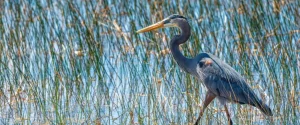
Boating offers the chance to see sharks and manatees, while paddlers will adore the 2.25-mile recreational canoe trail. The spacious 238-site campground caters to all rigs and covers the essential facilities: water/power hook-ups, picnic tables/BBQs, and washrooms.
Kolokee Loop Trail
A stone’s throw from downtown Orlando, this easy 5.6-mile trail is popular with city-dwellers seeking a quick nature escape. The balloon-shaped route resides in Little-Big Econ State Forest, a steamy subtropical region teeming with lazy alligators and curious raccoons. The most scenic portion follows the Florida Trail along the muddy swamplands of the Econlockhatchee River.
As the 5,000-acre state forest resides within the Orlando metropolitan region, you can expect to meet plenty of other hikers on the trail—it packs out on weekends. Little-Big Econ has a selection of lesser-traveled tracks if you’re yearning to escape the crowds.
Myakka River State Park Campground
A quintessential Florida wilderness experience, Myakka River State Park spans 58 acres of unadulterated natural bliss. From the prairies to the pinelands and wildlife-rich wetlands, a bewildering array of animals call Florida’s oldest state park home. Come to spot alligators sunning themselves on murky riverbanks and birdlife trudging through the marsh.
A solid selection of hiking trails meander through live oak forests, and there are plenty of pretty rivers to paddle a canoe. Accommodation options range from well-equipped cabins to primitive campsites—but the whole place can book out, so reserve well in advance.
Black Bear Wilderness Loop Hiking Trail
Near Lake Monroe to the north of Orlando, this fabulous 7.3-mile trip meanders through the Black Bear Wilderness Area. While its namesake does wander around the steamy hardwood marsh, you’re more likely to encounter harmless critters like turtles, otters, and birds.
Much of the moderate route passes over a series of 14 elevated boardwalks, although some sections involve trudging along bumpy root-festooned paths—it gets muddy after the rain. A few primitive campsites offer overnight stays en-route, but ensure you’re food is safely stashed away from roaming bears.
Ocala National Forest Campground
This 673-square-mile park houses the southernmost forest in the continental United States, ideal for a wild woodland escape. Some 600 lagoons, lakes, and springs lie throughout the thickly forested landscape, and you’ll find plenty of well-maintained trails to explore on foot. Secluded sinkholes and pioneer-era homesteads add even more reason for adventure.
The seldom-explored expanse is a top choice for campers seeking a secluded, middle-of-nowhere vibe—spring for the dispersed campgrounds. Dozens of other camping areas have options ranging from charming wood log cabins to tent-only sites and lakefront RV spots.
Florida Trail Ocala Section
For an epic, week-long backpacking trip, this famous 72-mile Florida Trail section leads you through pristine prairies, pine flatwood forests, and undulating sandhills. Expect to encounter abundant wildlife en route, including black bears, tortoises, and deer.
The Ocala National Forest route is the oldest and most popular portion of the 1,500-mile Florida Trail, which runs from the Panhandle right down to Big Cyprus National Reserve. Wild camping is permitted almost anywhere along this part of the trail, though restrictions apply in hunting season. Resupplying isn’t easy, so stock up in Paisley (northbound) or Palatka (southbound).
South Florida Campgrounds and Trails
While city-dwellers come for Miami’s sizzling social scene, nature lovers migrate this far south to see the Everglades and Florida’s sun-kissed keys.
Bahia Honda State Park Campground
Venture past the iconic Seven Mile Bridge, and you’ll arrive at this stunning seaside campsite in the Florida Keys. The 500-acre waterfront reserve wraps around an aqua-tinged half-crescent beach to afford million-dollar views. When you’re not soaking up the palm-thronged scene, you can paddle laps in a kayak, stroll the old Bahia Honda Rail Bridge, or snorkel the Looe Key National Marine Sanctuary.
Picture-perfect Golf of Mexico vistas and a salty sea breeze accompany its 80-odd campsites, which range from rustic to full-service affairs. As you’d imagine, it’s incredibly popular, so book well in advance.
Curry Hammock Nature Trail
This short but sweet trail meanders through a tropical rock-land hammock west of Bahia Honda State Park. While it’s only 0.4 miles long, it’s wise to slip out of your sliders because some sections can get seriously rugged—think roots, rocks, and wayward lizards. But it’s worth the impromptu shoe change to marvel at the lush thatch palms and scenic beaches of Curry Hammock State Park.
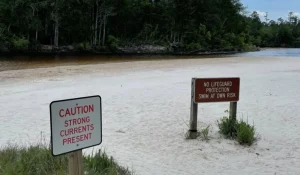
Pay attention to the poisonwood trees warning signs in the car park because you don’t want to stumble into these painful plants. Need more exercise? You’ll find numerous similar short walks throughout the Florida Keys, including Crane Point Hammock and the Windley Trail.
The Everglades Campground
The world-famous Everglades National Park is America’s number one spot to gawk at sun tanning gators and cruise tropical wetland swamps. Home to peaceful lakes, pristine prairies, and gushing seasonal rivers, the ‘River of Grass,’ as the Native Americans call it, is one of the country’s greatest natural treasures.
Because the vast muddy wilderness spans a staggering 1.5 million acres, you’ll need time to do it justice. Avid RVers can overnight at its two front country campgrounds (Long Pine Key and Flamingos) to stay close to the action. Both offer top-notch facilities and family-friendly activities—just remember to book way in advance.
Gator Hook Trail
Get ready to get your feet wet because this swampy Big Cypress National Preserve trail has you trudging through knee-high mud. The 2.4-mile Gator Hook Trail is the park’s premiere swamp walk, where brave hikers wade through wildlife-rich wetlands to get an up-close feel for the unique ecosystem. While it’s not for everyone, adventurous trekkers rave about the sloppy experience.
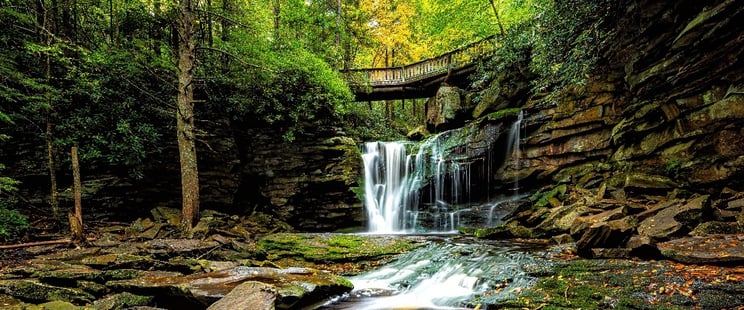
Located north of Everglades National Park, the expansive Big Cypress National Preserve forms part of the same ecosystem. A solid selection of boardwalk hikes, scenic drives, and boat tours offer off-the-beaten-track travelers a similar wetland experience away from the crowds.
Biscayne National Park Campground
Give South Florida’s thick tourist throngs a wide berth and treat yourself to tranquil, off-grid camping at Biscayne National Park. Despite residing just 31 miles from downtown Miami, these beautiful barrier islands receive few visitors as the only way to arrive is by boat. Unsurprisingly, sailing is the main form of transport and recreation on this roadless archipelago. Nonetheless, fishing, swimming, kayaking, snorkeling, SCUBA diving, and hiking offer ample adventures on water and land.
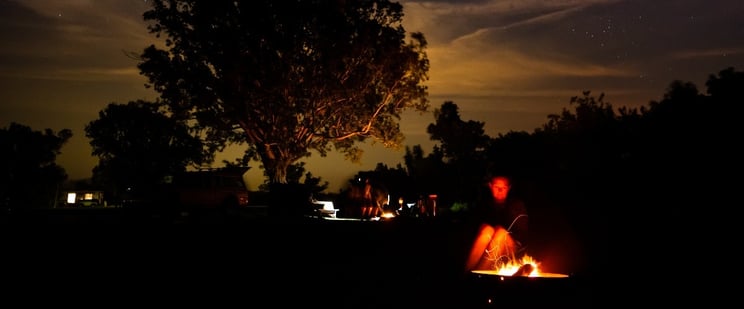
A public ferry from Homestead whisks boatless campers to Elliott Key Harbour, where a visitor’s center, hiking trails, and a well-equipped campground await. For more seclusion, set sail to Boca Chita Key and overnight at its rustic (toilets only) but scenic campground. Boca Chita Key is only accessible via private vessel, so you can guarantee the scene will be low-key.
Kitching Creek Nature Trail
Just north of the southeast urban sprawl lies the delightful Jonathan Dickinson State Park. Intersected by the murky Loxahatchee River, this spectacular wilderness offers a string of magnificent boardwalk mangrove hikes. The cream of the crop is Kitching Creek Nature Trail, a leisurely 1.5-mile stroll lined by vibrant pink orchids and lusciously green ferns. Tack on the Hobe Mountain Trail to enjoy a commanding panorama from its observation tower.
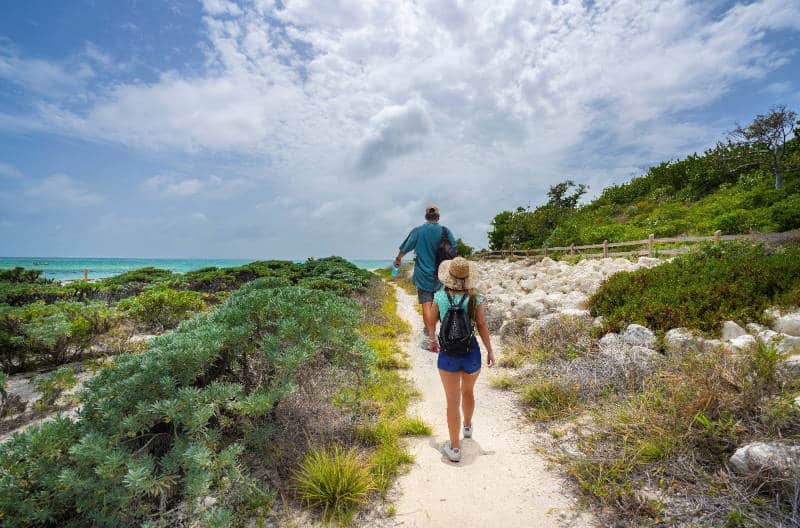
Scenic nature hikes aside, Jonathan Dickinson is a hit for its intriguing historical sites. Short, accessible walks lead to time-worn attractions like a WWII training camp and the “Wild Man of the Loxahatchee’s” fur trading hut.
Tips for Exploring Florida
Whether you’re a first-time visitor or a seasoned migratory snowbird, careful preparation is crucial for any trip to Florida. Follow these tips to make the most out of your outdoor adventures.
Be Sunsmart
They call it the “Sunshine State” for a reason. Florida averages 237 clear days per year, an entire month of sun above the national average.
Protect your pigmentation by slopping on sunscreen and wearing a wide-brimmed hat. Lightweight, loosely-fit long-sleeved clothing beats singlets and short shorts for those extended hikes.
Prepare for Rain
When the sun ain’t blazing in Florida, it’s probably pouring rain—pessimistic locals prefer to call it the “Rainy State.” The wettest months of July to September see the most frequent downpours, although heavy rains can occur throughout the year.
Keep an umbrella close at hand and pack a lightweight poncho on the trail.
Bring Bug Spray
If there’s one downside to Florida, it’s the unrelenting presence of biting bugs. From mosquitos to ticks and no-see-um midgies, these horrid little creatures will make your skin itch and swell.
Pack plenty of high-DEET bug spray and use it extra liberally around sundown. Again, covering your skin with long-sleeved apparel provides better protection.
Hike Safely
Dress for the weather and pack more water than you need to finish the hike. Biting insects and blaring sunshine threaten every hiker, so keep your sun cream and bug spray on hand.
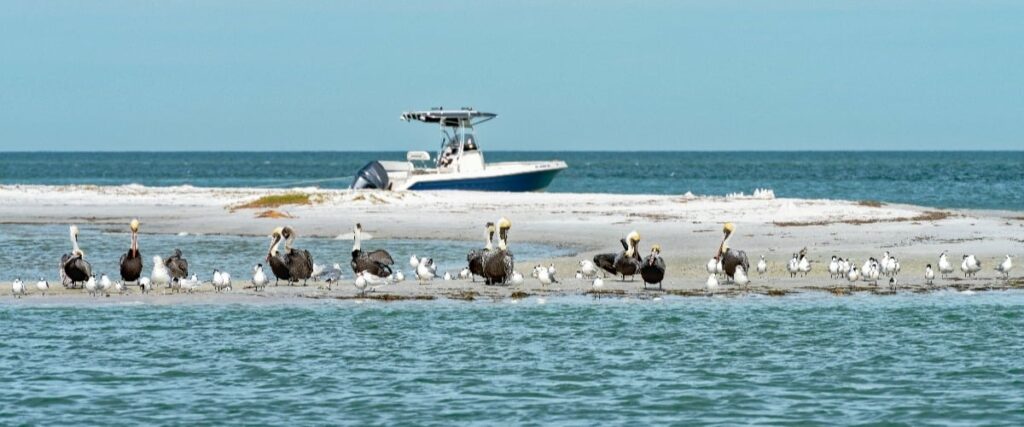
The last thing you want is to wander off the trail. Download offline maps onto your cellphone and use GPS to find your way. A backup battery bank can top you up when the juice starts to run low. And, although somewhat pricey, a Personal Location Beacon could save your life someday.
Keep an Eye Out for Wildlife
A plethora of potentially deadly animals calls Florida home. But no need to freak out. Understanding the best avoidance practices is almost guaranteed to keep you safe.
- American alligators: While these prehistoric beasts don’t dare attack full-sized humans, they can become aggressive when provoked. Keep your distance, especially when accompanied by children or dogs.
- Black bears: Stay well out of the way of these 300-pound behemoths. The shy species only defend itself when threatened—no unprovoked attacks have occurred in Florida.
- Bull sharks: Several shark species lurk in the waters around Florida, but it’s the bull shark you’ve got to watch out for. Avoid known shark-prone areas, swim with a buddy, and refrain from excessive splashing.
- Jellyfish: Although rare, a sting from a box jellyfish, lion’s mane, or Portuguese man-of-war is excruciating and potentially life-threatening. Heed warning signs and rinse the affected area with white vinegar if stung.
- Snakes: Six venomous snake species slither around the state, but all will skedaddle the second they hear you coming. Play it safe by sticking to the trail and avoiding long grass. Seek medical attention immediately should one sink their teeth in.
- Wild hogs: As the descendants of domestic pigs from the colonial era, these now-feral boars are fearsome and aggressive. The good news is the 200-pound brutes won’t attack if you keep your distance.
Enjoy the Great Outdoors in Florida
From the Panhandle to the Florida Keys, this sun-kissed state is blessed with otherwordly natural beauty. We’ve covered some of Florida’s top campsites and hiking trails, but there’s so much more out there to explore.
Take the time to savor the Sunshine State by stopping off at the secluded coves and refreshing springs you encounter along the way.
If you need somewhere safe to stash your rig during the off-season, we’ve got several top-notch storage facilities around the state.
Sleep tight knowing your toys are alright. Contact us today.
